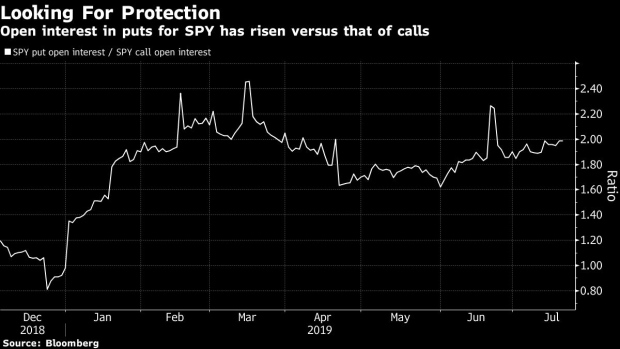Jul 19, 2019
Price of Prudence Is Nothing But Pain as Stock Dips Get Shorter
, Bloomberg News

(Bloomberg) -- Dump all of your equities and load up on derivatives. Hide out in short-term government bonds until the coming storm recedes. Toss your position altogether, yet be prepared to jump back into risk-parity quant strategies if the market keeps grinding higher.
Advice like this has been blaring forth for months from Wall Street strategists, positioning clients for the Big One -- a comeuppance for bulls following the best first-half rally in two decades. But despite all the intellectual firepower spent in the name of hedging, here’s what actually worked: sitting still.
That’s what Dan Chung is doing -- nothing. The chief executive officer of New York-based fund firm Alger says that to make money and even to prevent losses, you pick a bunch of steadily growing companies and forget about them. Defensive areas of the market may not fall as much when the going gets tough, but they’ll be behind when everything’s said and done.
“Usually what happens is investors go in too early, and then they come back too late," Chung, who has been CEO of the firm since 2006, said in an interview at Bloomberg’s New York headquarters. “And then they absolutely kill their returns.”
It’s a painful irony that in 2019, amid a rally that has added $5 trillion to U.S. equity values, Wall Street’s biggest obsession has been protecting against losses. All year long, investors have shunned stocks for bonds, sending more than $250 billion into fixed income while pulling $144 billion from equities, Bank of America Merrill Lynch research citing EPFR global data show. BlackRock Inc. CEO Larry Fink said Friday that people are under-invested.
Demand has burned brightest for defensive equities, with exchange-traded funds for real estate, communications and utilities companies each taking in more than $2 billion in the first half of the year. Every other sector, except for consumer staples, had outflows. In the options market, for contracts tied to the biggest S&P 500 ETF, total open interest in puts -- the amount of bearish contracts that haven’t been settled -- has risen this year versus that of bullish calls. A ratio of the two has nearly doubled since January.
Whether measures for cushioning losses ever work is a topic of debate on Wall Street. In March 2017, a researcher at AQR Capital Management, Roni Israelov, published a paper showing that even a simple strategy of buying bearish index options to insulate a portfolio from big market drawdowns has a “pathetic” record of effectiveness.
“Unless your option purchases and their maturities are timed just right around equity drawdowns, they may offer little downside protection,” Israelov wrote. “Unfortunately, equity drawdowns have lives of their own, which may not conveniently coincide with option expiration cycles. In these cases, the put option’s protective armor is easily penetrated.”
The S&P 500 fell 1.2% this week while the Dow Jones Industrial Average dropped 0.6%. Banks kicked off second quarter earnings season, with the likes of Goldman Sachs Group Inc., JPMorgan Chase & Co., Bank of America Corp., and others all delivering results. Big tech is gearing up for a busy week, with Google parent Alphabet Inc., Facebook Inc., and Amazon.com Inc. all set to report.
While hedging could easily turn out to have been wise, so far it’s been money that might’ve been spent elsewhere. Not only are U.S. stocks perched near record highs, but the dips have grown increasingly shallow, making it harder for investors to capitalize during volatile periods. The average S&P 500 drawdown from the highs so far this month hasn’t even reached 0.3%. That’s the smallest since January of 2018, when the S&P 500 shot up almost 6% in the aftermath of President Trump’s tax overhaul.
That’s left the benchmark’s 12-month forward P/E ratio trading at 17 times future earnings, the highest multiple of the year and greater than the level seen last September, before stocks spiraled into a near bear market.
“It’s really hard. For the most part, everything is rich,” Marvin Loh, global macro strategist at State Street, said in an interview at Bloomberg’s New York headquarters. “But at the same time, cash levels are really, really high. Valuations with all of the known unknowns is not enough to entice people to reduce those cash levels.”
Chung says investors should re-frame how they think about risk. The firm looked at how the performance of two classically safe sectors compared to high-growth industries during the bull market of today and the bear market of 2008. In short, unless you are possessed of supernatural prescience, the benefits of playing defense don’t even come close to offsetting the risk of missing out.
Still, it’s not easy. The higher it goes, the scarier it gets.
“I talk to people that are having fantastic years and they’re miserable,” said Julian Emanuel, BTIG’s chief equity and derivatives strategist. “They don’t know whether they should be taking their chips off the table, or even if they would be taking their chips off the table, whether you cut back your winners or cut back your underperformers. The environment has become so topsy-turvy.”
--With assistance from Vildana Hajric.
To contact the reporter on this story: Sarah Ponczek in New York at sponczek2@bloomberg.net
To contact the editors responsible for this story: Jeremy Herron at jherron8@bloomberg.net, Chris Nagi
©2019 Bloomberg L.P.





